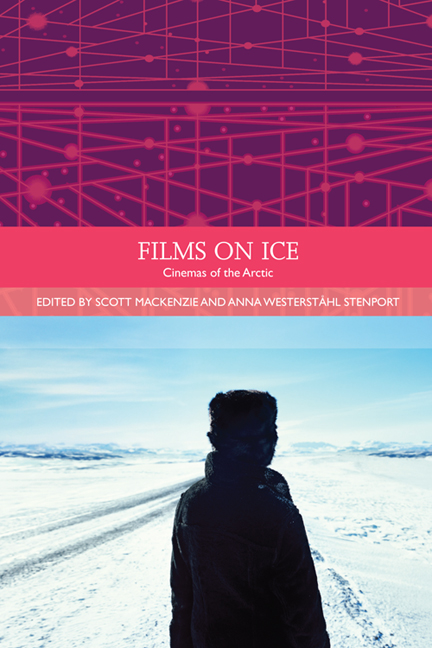Book contents
- Frontmatter
- Contents
- List of Illustrations
- Acknowledgements
- Traditions in World Cinema
- Introduction: What are Arctic Cinemas?
- PART I GLOBAL INDIGENEITY
- 1 ‘Who Were We? And What Happened to Us?’: Inuit Memory and Arctic Futures in Igloolik Isuma Film and Video
- 2 Northern Exposures and Marginal Critiques: The Politics of Sovereignty in Sámi Cinema
- 3 Frozen in Film: Alaska Eskimos in the Movies
- 4 Cultural Stereotypes and Negotiations in Sámi Cinema
- 5 Cinema of Emancipation and Zacharias Kunuk's Atanarjuat: The Fast Runner
- 6 Cosmopolitan Inuit: New Perspectives on Greenlandic Film
- 7 Arctic Carnivalesque: Ethnicity, Gender and Transnationality in the Films of Tommy Wirkola
- PART II HOLLYWOOD HEGEMONY
- PART III ETHNOGRAPHY AND THE DOCUMENTARY DILEMMA
- PART IV MYTHS AND MODES OF EXPLORATION
- Notes on the Contributors
- Index
3 - Frozen in Film: Alaska Eskimos in the Movies
from PART I - GLOBAL INDIGENEITY
Published online by Cambridge University Press: 05 September 2016
- Frontmatter
- Contents
- List of Illustrations
- Acknowledgements
- Traditions in World Cinema
- Introduction: What are Arctic Cinemas?
- PART I GLOBAL INDIGENEITY
- 1 ‘Who Were We? And What Happened to Us?’: Inuit Memory and Arctic Futures in Igloolik Isuma Film and Video
- 2 Northern Exposures and Marginal Critiques: The Politics of Sovereignty in Sámi Cinema
- 3 Frozen in Film: Alaska Eskimos in the Movies
- 4 Cultural Stereotypes and Negotiations in Sámi Cinema
- 5 Cinema of Emancipation and Zacharias Kunuk's Atanarjuat: The Fast Runner
- 6 Cosmopolitan Inuit: New Perspectives on Greenlandic Film
- 7 Arctic Carnivalesque: Ethnicity, Gender and Transnationality in the Films of Tommy Wirkola
- PART II HOLLYWOOD HEGEMONY
- PART III ETHNOGRAPHY AND THE DOCUMENTARY DILEMMA
- PART IV MYTHS AND MODES OF EXPLORATION
- Notes on the Contributors
- Index
Summary
THE ESKIMO IMAGE IN TWENTIETH-CENTURY CINEMA
In 1995 I published a book entitled Freeze Frame: Alaska Eskimos in the Movies. By that time, I had already worked as a cultural anthropologist for more than twenty years among Yup'ik people in southwest Alaska. I was motivated by a keen interest in the evolution of the Eskimo stereotype, which failed in so many ways to fit the people I had come to know. Eskimos, I had learned as a child, were happy smiling folk, living peacefully in igloos in small, nuclear family groups including noble hunter, wife and child. Their environment was harsh and unforgiving, requiring constant efforts to survive. My Yup'ik friends, in contrast, lived in a rich environment where food was abundant every season of the year. Moreover, they had a complicated and rich history. In winter they gathered in large settlements made up of homes of sod, not snow, for women and small children, as well as one or more qasgit (semi-subterranean communal men's houses) where up to thirty men and boys over the age of five worked, ate and slept together. Far from peaceful, they engaged in bloody bow-and-arrow wars of revenge and retaliation into the early 1800s, until epidemic diseases left their traditional regional groups diminished in size and strength.
The Eskimo stereotype, in fact, originated in the Canadian Arctic, familiar to Euro-Americans a century before the first non-Natives ever set foot in Alaska. When I began work in southwest Alaska in 1974, Yup'ik people and their history and traditions were poorly understood by non-Natives. Small wonder the gap between image and reality was so large. Fired by this misfit, I conceived the idea of a book on the Eskimo image with chapters covering children's stories, fiction, scholarly and exploration literature, and the movies. I started with this last chapter, and Freeze Frame was the result. For the book's cover, the designer chose a photo of Inupiaq actor Ray Mala, Alaska's first and still most prolific Hollywood star, rubbing noses with his smiling co-star, demonstrating the famous ‘Eskimo kiss’. An Athabascan friend once confided to me how offended he was by this cover photograph but that, when he read my book, he loved it. A sobering compliment indeed.
- Type
- Chapter
- Information
- Films on IceCinemas of the Arctic, pp. 59 - 71Publisher: Edinburgh University PressPrint publication year: 2014



